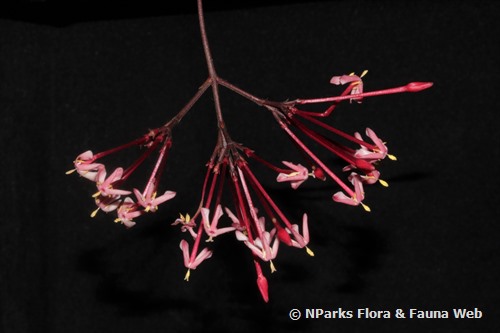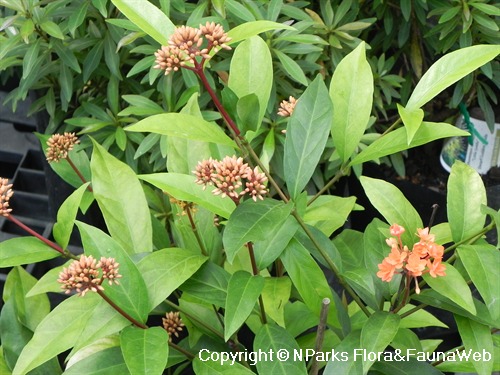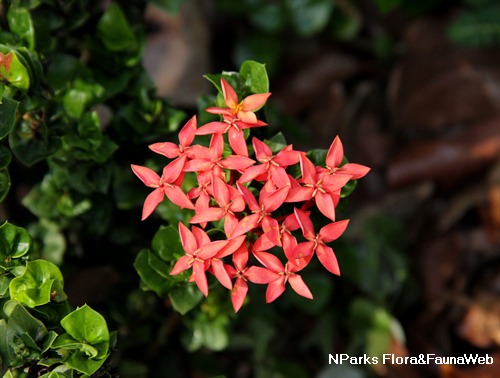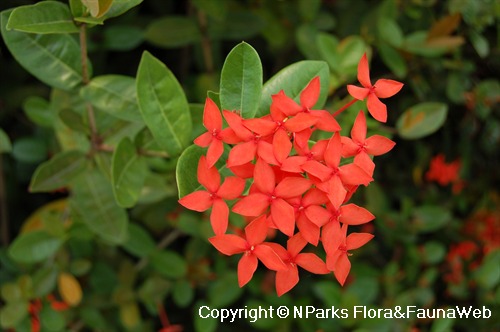
Back
Ixora pendula Jack
| Family Name: | Rubiaceae |
| Synonyms: | Ixora candida Ridl., Ixora opaca Don |
| Common Name: | Pink Needles, Bunga Merak Hutan, Jarum-Jarum, Bunga Tabong Jarum, Jambul Siul, Mata Pialing, Medang Asam, Medang Terkukur, Memalai Hutan, Mentua Pelandok, Nyarum-Nyarum, Pekan Ayam, Rambai Kuau |
Name
Classifications and Characteristics
| Plant Division | Angiosperms (Flowering Seed Plants) (Dicotyledon) |
|---|---|
| Plant Growth Form | Shrub, Tree (Small (6m-15m)) |
| Lifespan (in Singapore) | Perennial |
| Mode of Nutrition | Autotrophic |
| Plant Shape | Irregular |
| Maximum Height | 10 m |
Biogeography
| Native Distribution | Thailand, Sumatra, Peninsular Malaysia, and Singapore |
|---|---|
| Native Habitat | Terrestrial (Primary Rainforest, Secondary Rainforest) |
| Preferred Climate Zone | Tropical |
| Local Conservation Status | Native to Singapore (Endangered (EN)) |
Description and Ethnobotany
| Growth Form | It is a shrub or small tree up to 10 m tall. |
|---|---|
| Foliage | Its stalked, opposite leaves have leathery blades that are usually oblong to elliptic, 23–28 by 6.4–8.9 cm, and have 12–16 pairs of veins. |
| Flowers | Its flowers are pink with white petals, 5 mm long, and arranged at the end of branches in clusters with 2 small leaves at the base. |
| Fruit | Its fruit is ellipsoid, deep purple, and 5 mm long. |
| Habitat | It grows in inland forests. It occurs locally in Pulau Ubin, Central Catchment Nature Reserve (including Upper Seletar Reservoir), and Bukit Timah Nature Reserve. |
| Associated Fauna | Its flowers are pollinated by birds. |
| Cultivation | It can be propagated by seed. |
| Etymology | Ixora, the name of a Malabar deity, Iswara; Latin pendula, drooping, referring to the hanging position of the plant’s flowers or fruit |
| Ethnobotanical Uses | Medicinal: Its leaves are said to be used medicinally. |
Landscaping Features
| Landscaping | It is suitable for parks for its ornamental pendulous inflorescence. |
|---|---|
| Desirable Plant Features | Ornamental Flowers |
| Landscape Uses | Parks & Gardens, Small Gardens |
Fauna, Pollination and Dispersal
| Fauna Pollination Dispersal Associated Fauna | Bird-Attracting (Fruits, Flowers) |
|---|---|
| Pollination Method(s) | Biotic (Fauna) (Vertebrates (Bird)) |
| Seed or Spore Dispersal | Biotic (Fauna) |
Plant Care and Propagation
| Light Preference | Semi-Shade |
|---|---|
| Water Preference | Moderate Water |
| Plant Growth Rate | Moderate |
| Rootzone Tolerance | Moist Soils, Well-Drained Soils, Fertile Loamy Soils |
| Propagation Method | Seed |
Foliar
| Foliage Retention | Evergreen |
|---|---|
| Mature Foliage Colour(s) | Green |
| Mature Foliage Texture(s) | Leathery |
| Foliar Type | Simple / Unifoliate |
| Foliar Arrangement Along Stem | Opposite |
| Foliar Attachment to Stem | Petiolate |
| Foliar Shape(s) | Non-Palm Foliage (Elliptical, Oblong) |
| Foliar Venation | Pinnate / Net |
| Foliar Margin | Entire |
| Leaf Area Index (LAI) for Green Plot Ratio | 4.5 (Shrub & Groundcover - Dicot) |
Floral (Angiosperm)
| Flower & Plant Sexuality | Bisexual Flowers |
| Flower Colour(s) | Pink, White |
|---|---|
| Flower Grouping | Cluster / Inflorescence |
| Flower Location | Terminal |
| Flower Symmetry | Radial |
| Individual Flower Shape | Tubular |
Fruit, Seed and Spore
| Mature Fruit Colour(s) | Black, Purple |
|---|---|
| Fruit Classification | Simple Fruit |
| Fruit Type | Fleshy Fruit , Non-Accessory Fruit |
Image Repository
Others
| Master ID | 846 |
|---|---|
| Species ID | 2141 |
| Flora Disclaimer | The information in this website has been compiled from reliable sources, such as reference works on medicinal plants. It is not a substitute for medical advice or treatment and NParks does not purport to provide any medical advice. Readers should always consult his/her physician before using or consuming a plant for medicinal purposes. |








